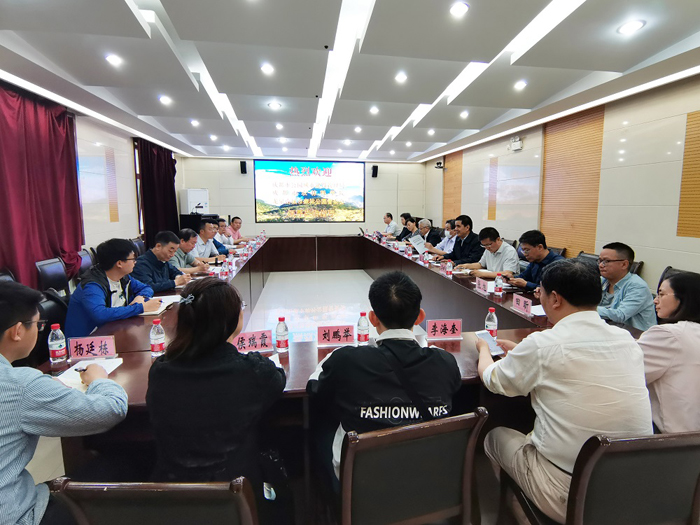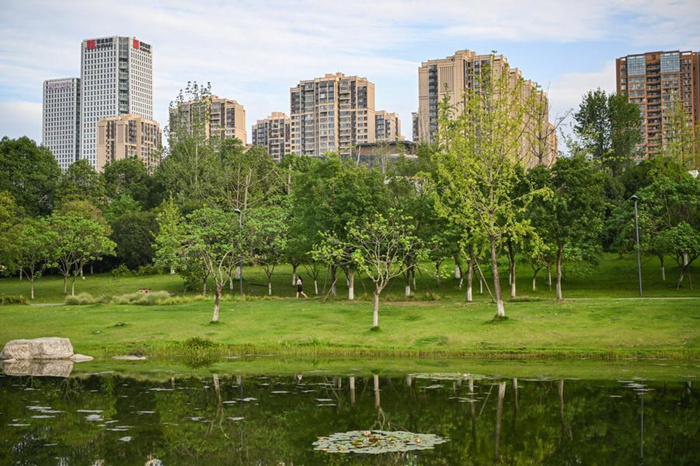
国内外城市树木孢粉致敏研究进展
编号
lyqk009497


中文标题
国内外城市树木孢粉致敏研究进展


作者单位
西南交通大学建筑与设计学院风景园林系,成都 611756


期刊名称
世界林业研究


年份
2021


卷号
34


期号
3


栏目名称
专题论述


中文摘要
城市绿色空间是市民与环境互动、维持人类健康的重要空间。在城市绿色空间中部分树木释放出的孢粉(孢子与花粉)会诱过敏反应,严重威胁人类健康。根据世界卫生组织预测,未来20年内将会有35%的世界人口对孢粉产生过敏反应。文中综述国内外65个主要城市树木孢粉致敏的研究进展,梳理孢粉致敏的研究历程和监测方法,比较得出城市中引发孢粉致敏的主要树种及风险期;在此基础上,归纳出诱导城市树木孢粉致敏发生率提升的4大因素——气候因子、城市空气污染物、城市绿化方式以及植物之间的交叉反应,并提炼出目前树木孢粉致敏研究存在的短板;从5个方面阐述孢粉致敏对公园城市营造的启示,并提出未来研究展望,以期科学指导我国公园城市的园林建设,推动“健康中国”发展战略的实施。


基金项目
国家自然科学基金面上项目“基于节约型乡村景观设计理念的川西林盘乔木景观生态水文效应研究”(31971716);四川省科技厅项目(20RKX0670);四川省社会科学研究“十三五”规划资助项目(SC19B138)


英文标题
A Review of the Research on Urban Trees Pollen Allergy


作者英文名
Zong Hua, Yao Manqing, Wu Xiaoyi


单位英文名
School of Architecture and Design, Southwest Jiaotong University, Chengdu 611756, China


英文摘要
Urban green spaces are the vital space for the interaction between citizens and the environment and human health improvement. However, the pollen released from urban trees may induce the allergy, which is a serious threat to human health. According to data from the World Health Organization, 35% of the world’s population will have an allergic reaction to pollen in the next 20 years. Thus, by reviewing urban tree pollen allergy researches on 65 major cities, the paper summarizes the research history of pollen allergy research and the assessment method used, and then compares the allergic tree species and the risk period in these cities. The 4 factors that can induce and increase the occurrence of urban tree pollen allergy are concluded, i.e., climate factors, urban air pollutants, urban greening strategies and the interactions among plants, and points out the shortcomings of the current researches. Then the enlightenment of the researches on urban park establishment are expounded from 5 perspectives, with the purpose to provide scientific guidance for the park city landscaping and to promote the implementation of the “Healthy China” strategy.


英文关键词
urban tree;pollen;allergy;park city


起始页码
38


截止页码
45


投稿时间
2020/5/27


最后修改时间
2020/9/18


作者简介
宗桦,女,西南交通大学风景园林系副教授、硕士生导师,四川大学植物学博士,澳大利亚昆士兰大学农业与食品学院访问学者,主要研究方向为园林生态,E-mail:huangjiaqiutian@aliyun.com


E-mail
huangjiaqiutian@aliyun.com


分类号
S718.43,S731


DOI
10.13348/j.cnki.sjlyyj.2020.0094.y


参考文献
[1] LIU X, HU G, CHEN Y, et al. High-resolution multi-temporal mapping of global urban land using landsat images based on the Google Earth Engine Platform[J]. Remote Sensing of Environment, 2018, 209:227-239.
[2] SAMSON R, GROTE R, CALFAPIETRA C, et al. Urban trees and their relation to air pollution[M]//PEARLMUTTER D. The urban forest.Cham, Switzerland:Springer, 2017: 21-30.
[3] 任继勤, 郑惠潆. 中美城市树木碳储存的现状对比研究[J]. 森林工程,2016,32(4):28-30.
[4] 李玉杰, 张晋东, 白文科, 等. 北京不同功能绿地昆虫群落组成和生物多样性特征[J]. 生态环境学报,2018,27(6):1044-1051.
[5] 沈剑, 李蓓蓓, 郑国良, 等. 城市树木对空气颗粒物的影响综述[J]. 安徽农业科学,2019,47(21):8-11.
[6] DUNN-JOHNSTON K A, KREUZWIESER JüRGEN, SATOSHI H, et al. Isoprene emission factors for subtropical street trees for regional air quality modeling[J]. Journal of Environment Quality, 2016, 45(1):234-243.
[7] CARI?ANOS P, CASARES-PORCEL M. Urban green zones and related pollen allergy: a review: some guidelines for designing spaces with low allergy impact[J]. Landscape and Urban Planning, 2011, 101(3):205-214.
[8] 郑扬. 城市森林生态系统服务功能研究概述与展望[J]. 防护林技,2019(10):53-56.
[9] 吴慧, 张亚杰, 马玉霞, 等. 近57年海南省花粉过敏天数的时空分布特征及其变化[C]//第35届中国气象学会年会论文集. 合肥: 中国气象学会, 2018: 117-122.
[10] BLACKELY C H. Experimental researches on the nature and causes of catarrhus aestivus[M]. Londrés: Bailliere, Tindal & Cox, 1873.
[11] JOCHNER-OETTE S, STITZ T, JETSCHNI J, et al. The influence of individual-specific plant parameters and species composition on the allergenic potential of urban green spaces[J]. Forests, 2018, 9(6):284-298.
[12] HABERLE S G, BOWMAN D M, NEWNHAM R M, et al. The macroecology of airborne pollen in Australian and New Zealand urban areas[J]. Plos One, 2014, 9(5):e97925. DOI:10.1371/journal.pone.0097925
[13] 江伟明, 潘睿聪, 罗传秀, 等. 城市空气花粉的研究进展[J]. 生态科学,2018,37(6):199-208.
[14] 赖乃揆, 翟月明, 贺紫兰, 等. 广州市部分地区空气中花粉及其致敏性的初步调查[J]. 广州医学院学报,1982,18(3):219-220.
[15] 曾继红, 洪苏玲, 黄江菊. 重庆市渝中区气传致敏花粉调查[J]. 重庆医学,2004(2):216-218.
[16] 孟光. 海南省海口市气传花粉调查[J]. 中国中西医结合耳鼻咽喉科杂志,2005(4):233-235.
[17] DURHAM O C. The volumetric incidence of atmospheric allergens: II. simultaneous measurements by volumeric and gravity slide methods: results with ragweed pollen and alternaria spores[J]. Journal of Allergy, 1944, 15(3):226-235.
[18] SOLOMON A M, HAYES H D. Impacts of urban development upon allergenic pollen in a desert city[J]. Journal of Arid Environments, 1980, 3(2):169-178.
[19] HONG C S. Pollen allergy plants in Korea[J]. Allergy, Asthma & Respiratory Disease, 2015, 3(4):239-254.
[20] 张贵生, 张安学, 李小玲, 等. 20年前后西安市城区气传致敏花粉种类和含量的对比分析[J]. 中华临床免疫和变态反应杂志,2007,1(2):167-171.
[21] HIRST J M. An automatic volumetric spore trap[J]. The Annals of Applied Biology, 1952, 39(2):257-265.
[22] 孟龄, 王效科, 欧阳志云, 等. 北京城区气传花粉季节特征及与气象条件关系[J]. 环境科学,2016,37(2):452-458.
[23] SERCOMBE J K, GREEN B J, RIMMER J, et al. London plane tree bioaerosol exposure and allergic sensitization in Sydney, Australia[J]. Annals of Allergy Asthma & Immunology, 2011, 107(6):493-500.
[24] KISHIKAWA R, SAHASHI N, SAITOH A, et al. Japanese cedar airborne pollen monitoring by Durham's and Burkard samplers in Japan-estimation of the usefulness of Durham's sampler on Japanese cedar pollinosis[J]. Global Environmental Research, 2009, 13(1):55-62.
[25] BELMONTE J, CANELA M, GUàRDIA R-A. Comparison between categorical pollen data obtained by Hirst and Cour sampling methods[J]. Aerobiologia, 2000, 16(2):177-185.
[26] HRUSKA K. Assessment of urban allergophytes using an allergen index[J]. Aerobiologia, 2003, 19(2):107-111.
[27] CARI?ANOS P, CASARES-PORCEL M, QUESADA-RUBIO J M. Estimating the allergenic potential of urban green spaces: a case-study in Granada, Spain[J]. Landscape and Urban Planning, 2014, 123:134-144.
[28] MRDAN S, LJUBOJEVI? M, ORLOVI? S, et al. Poisonous and allergenic plant species in preschool’s and primary school’s yards in the city of Novi Sad[J]. Urban Forestry & Urban Greening, 2017, 25:112-119.
[29] 李英, 李月丛, 吕素青, 等. 石家庄市空气花粉散布规律及与气候因子的关系[J]. 生态学报,2013,34(6):1575-1586.
[30] MOLINA R T, RODRíGUEZ A M, Palaciso I S, et al. Pollen production in anemophilous trees[J]. Grana, 1996, 35(1):38-46.
[31] OKUDA M. Epidemiology of Japanese cedar pollinosis throughout Japan[J]. Annals of Allergy Asthma & Immunology, 2003, 91(3):288-296.
[32] EMBERLIN J, SMITH M, CLOSE R, et al. Changes in the pollen seasons of the early flowering trees Alnus spp. and Corylus spp. in Worcester, United Kingdom, 1996—2005[J]. International Journal of Biometeorology, 2007, 51:181-191.
[33] DE LEóN D G, GARCíA-MOZO H, GALáN C, et al. Disentangling the effects of feedback structure and climate on Poaceae annual airborne pollen fluctuations and the possible consequences of climate change[J]. Science of the Total Environment, 2015, 530:103-109.
[34] ZHANG Y, BIELORY L, MI Z, et al. Allergenic pollen season variations in the past two decades under changing climate in the United States[J]. Global Change Biology, 2015, 21:1581-1589.
[35] FREI T, LEUSCHNER R M. A change from grass pollen induced allergy to tree pollen induced allergy: 30 years of pollen observation in Switzerland[J]. Aerobiologia, 2000, 16(3):407-416.
[36] LINDERHOLM H W. Growing season changes in the last century[J]. Agricultural and Forest Meteorology, 2006, 137(1/2):1-14.
[37] XU J X, ZHANG D S, LI L H. Seasonal variations of airborne pollen in Beijing, China and their relationships with meteorological factors[J]. Acta Ecologica Sinica, 2012, 32(4):202-208.
[38] 辛嘉楠, 欧阳志云, 郑华, 等. 城市化加剧花粉过敏症的机制研究进展[J]. 环境与健康杂志,2007,24(10):833-836.
[39] 肖小军, 胡东生, 刘志刚, 等. 深圳市气传致敏花粉调查及其与气候条件相关性研究[J]. 江西师范大学学报(自然科学版),2015,39(6):580-583.
[40] PACINI E, HESSE M. Cytophysiology of pollen presentation and dispersal[J]. Flora, 2004, 199(4):273-285.
[41] KAZLAUSKAS M, SAULIENE I, LANKAUSKAS A. Airborne artemisia pollen in Siauliai (Lithuania) atmosphere with reference to meteorological factors during 2003—2005[J]. Acta Biologica Universitatis, 2005, 6:1-2.
[42] JESUS R, ANA R, BEATRIZ L, et al. Effect of land uses and wind direction on the contribution of local sources to airborne pollen[J]. Science of the Total Environment, 2015, 538:672-682.
[43] 方伊曼. 南京仙林地区大气花粉传播规律及其与气象要素的关系研究[D]. 南京: 南京大学, 2015.
[44] ECKL-DORNA J, KLEIN B, REICHENAUER T G, et al. Exposure of rye (Secale cereale) cultivars to elevated ozone levels increases the allergen content in pollen[J]. Journal of Allergy and Clinical Immunology, 2010, 126(6):1315-1317.
[45] SEDGHY F, VARASTEH A, SANKIAN M, et al. Interaction between air pollutants and pollen grains: the role on the rising trend in allergy[J]. Reports of Biochemistry & Molecular Biology, 2018, 6(2):219-224.
[46] 戚继忠, 魏进华, 张倩, 等. 城市树木滞尘能力研究及存在的问题与对策[J]. 世界林业研究,2013,26(3):52-57.
[47] CARI?ANOS P, ADINOLFI C, DE LA GUARDIA C D, et al. Characterization of allergen emission sources in urban areas[J]. Journal of Environmental Quality, 2016, 45(1):244-252.
[48] JOHNSON W T. Allergy-free gardening: the revolutionary guide to healthy landscaping[J]. Electronic Green Journal, 2000, 1(13):267-270.
[49] WEBER, RICHARD W. Patterns of pollen cross-allergenicity[J]. Journal of Allergy and Clinical Immunology, 2003, 112(2):229-239.
[50] 邵洁, 罗海燕, PUROHIT A, 等. 桦树花粉过敏症相关的食物过敏综合症一例[J]. 中华儿科杂志,2005,43(2):149-150.


发布日期
2020-09-25


PDF全文
浏览全文


-
相关记录
更多
- 居民的生态系统文化服务需求与公园可达性的关系 2022
- 生态文明建设战略下公园城市生态价值转化研究动态 2021
- 城市废弃铁路生态化有机更新利用策略 2020
- 无人机遥感技术在城市树木智慧化管理中的应用 2017
- 城市树木滞尘能力研究及存在的问题与对策 2013
- 城市树木整形修剪技术探讨 2011
 打印
打印

